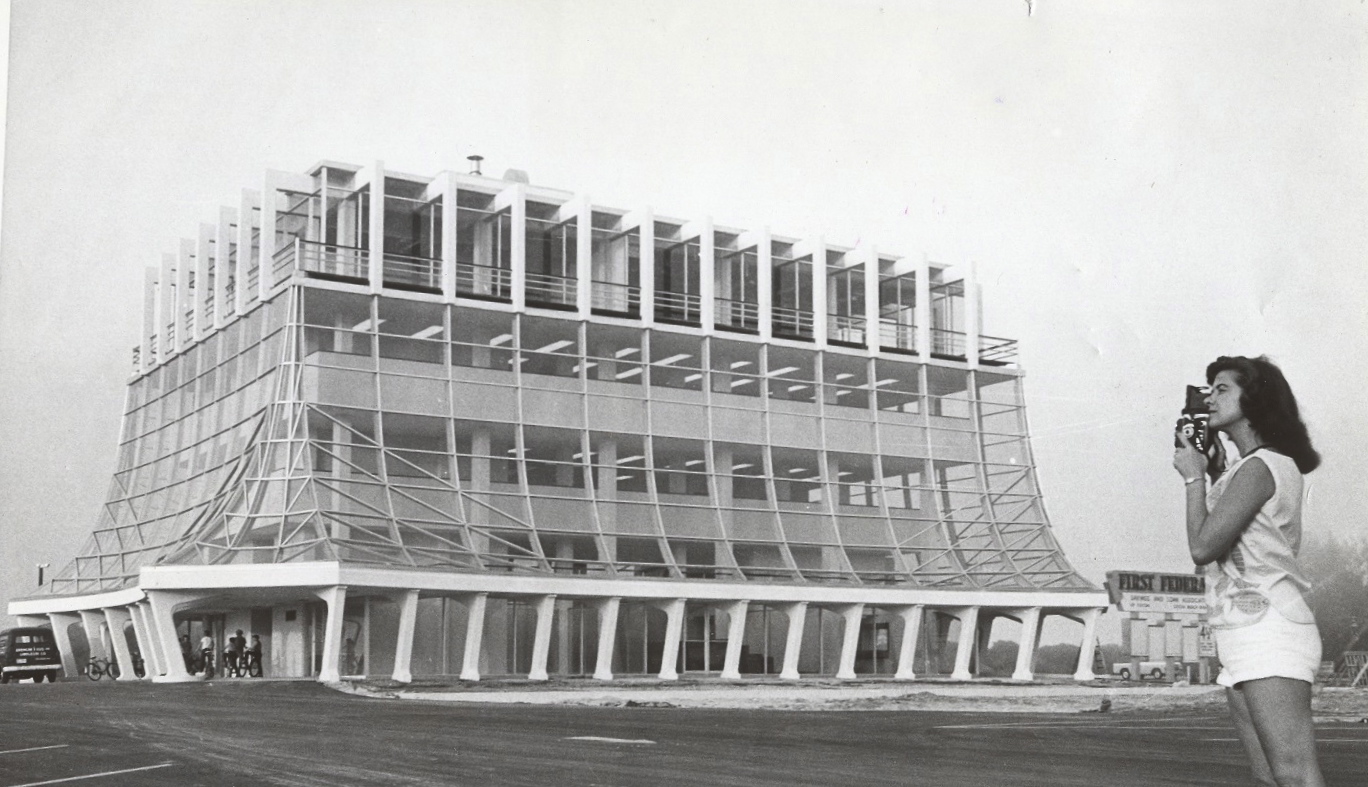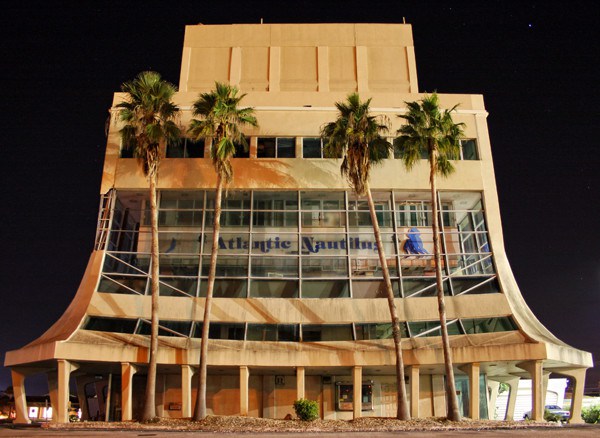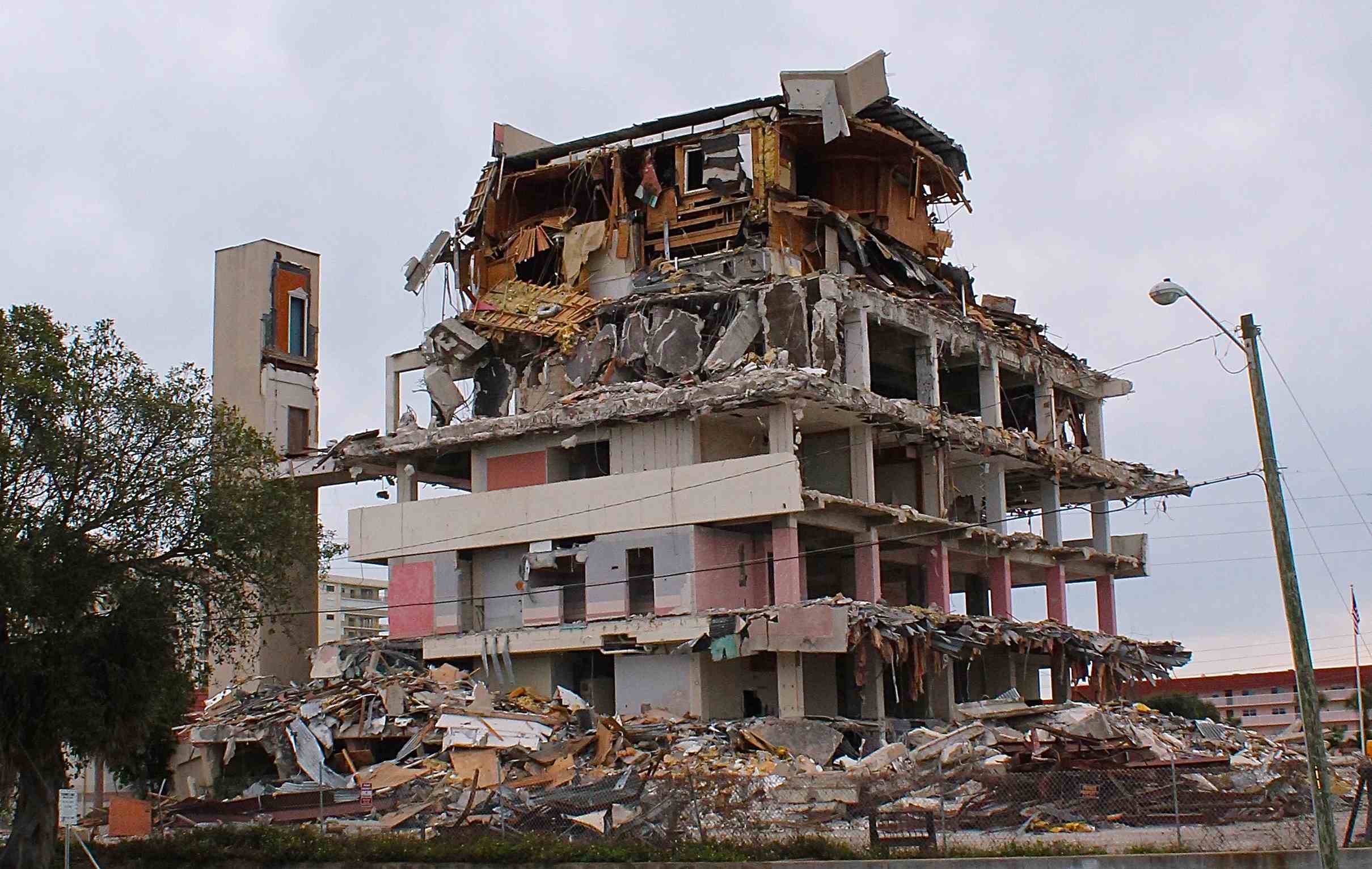![]()
HOME------FICTION------NON-FICTION------LOCALS------ABOUT![]()
The Glass Bank: Masterpiece to Dust
The Beachside Resident, February 2015

The Glass Bank––brainchild of world-renowned architect Reginald Caywood Knight––arose from the barrier island in 1961. It was an audacious gesture, even for the Cocoa Beach of a burgeoning space age, a five-story jewel encased in concave sweeps of glass, with all four walls yearning heavenward.
In 1963, Ramon's Rainbow Room, zenith lounge of modern times, took over the penthouse. The Rainbow Room was a cocktail and jazz joint, a place for astronauts and celebrities to tinkle their ice over river and sea. 1963 was a mythological year for this white-sand city, launchpad of Project Mercury, home to young heroes and geniuses, a year when the Glass Bank styled itself among the icons of modernity.
What path leads from glamour to ruin? You might blame it on the space bust of the 60's, or the drug-riddled aftershocks of Nam, or the malaise and despair of the disco age. You might blame it on recessions, on layoffs, on depressed property prices, on the steady, gradual degradation of downtown, on hurricanes or lawyers or men possessed... but that would be the inside story.
Fifty years later, the landmark stood cracked and grotesque, a hulking shambles, spewing lumber and rot, spending its last days like an actress made unrecognizable by years of botched surgery attempts: wheezing, forgotten, rattling her bones under the cold glare of the hospital staff.
The tragic flaw of the Glass Bank was clear enough to anyone who cared to look at her façade: it was her ill-fitting crown, the 1981 concrete penthouse addition, so willfully antagonistic of the intentions of Architect Knight––a windowless box, devoid of glass, off-kilter, a brutalist plug, blockading the cosmic flight of her skirt walls.

The 1981 team stuccoed over the lower corner windows, further reducing the organic feel, and face-mounted a concrete fortification wall over the modernist lines of the balcony, which had kept the upper floors in harmony with the angled, modernist colonnade of the ground floor.
This concrete afterbirth, this lobotomizing of the Glass Bank, serves as a cautionary tale for aesthetes and libertarians alike. Any municipal system that allows permitting of what amounts to a "floating strip club" atop its one true architectural masterpiece has deeply flawed historical ordinances. No consideration was made, even, to hide the maintenance staircase from the road. Rather, it was flaunted, like a jagged scar atop the beast's head.
But the 1981 renovations did not technically kill the Glass Bank. They only killed its context. The business of laying the actual structure to rest would fall, in the end, to the people of Cocoa Beach.
Last month, Dr. Lori Walters, a professor of history at UCF, presented "The Glass Bank: History of an Icon" at the Cocoa Beach library. Over two hundred people crowded the hall for the lecture. Another two hundred were sent away over fire safety concerns. Attendees were invited to participate. They reminisced about the fabled Caesar salad dressing at the Rainbow Room, the A&P in the First Federal Plaza, the Polaris and the Starlite Paladium, of Wolfie's and Brassy's.
Across the street, the people of Cocoa Beach were hard at work, demolishing their 82-foot-tall white elephant. The scream of steel girders and the crunch of stucco played strange accompaniment to the historical discussion.
A long-necked track hoe with a jackhammer slammed its head into the structure in crushing blows, worked its way around the old landmark like a laborer removing a section of sidewalk with a hand chisel. A tiresome process. Rubble swelled at her haunches. The demolition crews lingered for weeks, for months.

People watched from street corners, dodging hunks of concrete, contemplating her deconstruction, first her skirt walls, then her stucco, then her bearing columns. They had expected a wrecking ball, maybe, or dynamite. Something more expeditious. Her inside story drifted in whispery vapors and tufts of insulation about their heads. The people coughed, shielded their eyes from the dust. Bitter memories resurfaced: negligent property owners locking horns in the courts, nearly half a million dollars in forgiven city fines, decades of mold and broken glass, municipal coffers opened wide to loan the money for the demolition of the old "eyesore."
But forget the inside story for a moment.
"Certainly the year you were first exposed to the building plays a role in how you feel about it," Dr. Walters said. "Regardless of your vantage point, the community has lost yet another link to an era when the space program defined Cocoa Beach." She will be giving a repeat performance of her presentation on February 13, at 2 PM, at the Cocoa Beach Library, for those turned away from the first run.
The people of Cocoa Beach will wax nostalgic; they will reflect upon her ghost, comb over faded pictures and computer renderings. A few will remember the Glass Bank as she once was, stripped of the corrosion of the decades, in her high fashion days. By then, the crews should be sweeping her remains off the asphalt. The outside story of an icon: put to rest in dramatic, conclusive fashion.
The inside story will not go down so easily. Lawyers, it would seem, are more persistent than steel and concrete. The property retains its 82 feet of air rights, and in the end, something more massive, and less visionary, might go up in its stead.
In the meantime, the sun will shine in places that haven't seen the light of day in fifty years. And the people of Cocoa Beach will begin the work of forgetting.
Photo #1 - Glass Bank c. 1961 - courtesy of Dr. Lori Walters.
Photo #2 - Glass Bank c. 2011 - by Nomeus.
Photo #3 - Glass Bank c. 2015 - by the author.
![]()
